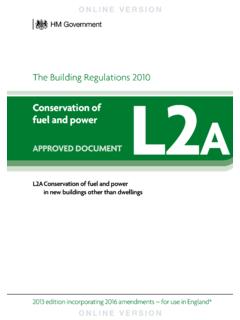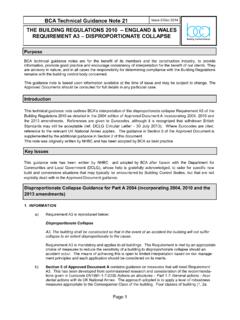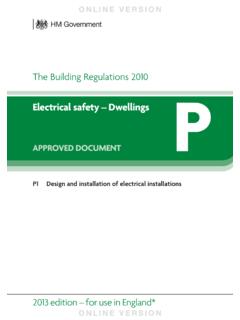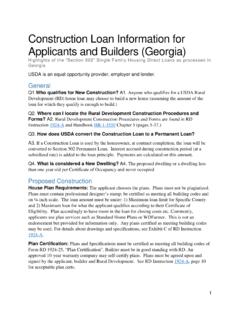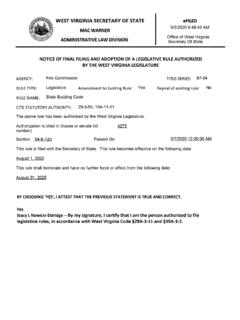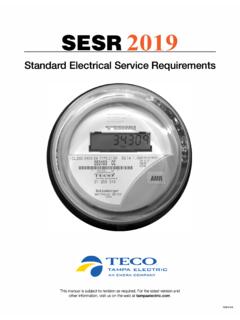Transcription of Natural ventilation in non-domestic buildings
1 Natural ventilation in non-domestic buildings CIBSE Applications Manual AM10. The rights of publication or translation are reserved. No part of this publication may be reproduced, stored in a retrieval system or transmitted in any form or by any means without the prior permission of the Institution. March 2005 The Chartered Institution of Building Services Engineers London Registered charity number 278104. ISBN 1 903287 56 1. This document is based on the best knowledge available at the time of publication. However no responsibility of any kind for any injury, death, loss, damage or delay however caused resulting from the use of these recommendations can be accepted by the Chartered Institution of Building Services Engineers, the authors or others involved in its publication.
2 In adopting these recommendations for use each adopter by doing so agrees to accept full responsibility for any personal injury, death, loss, damage or delay arising out of or in connection with their use by or on behalf of such adopter irrespective of the cause or reason therefore and agrees to defend, indemnify and hold harmless the Chartered Institution of Building Services Engineers, the authors and others involved in their publication from any and all liability arising out of or in connection with such use as aforesaid and irrespective of any negligence on the part of those indemnified. Typeset by CIBSE Publications Printed in Great Britain by Page Bros.
3 (Norwich) Ltd., Norwich, Norfolk NR6 6SA. Cover illustration: Bedales School Theatre, Hampshire (courtesy of Feilden Clegg Bradley Architects; photo: Dennis Gilvert). Note from the publisher This publication is primarily intended to provide guidance to those responsible for the design, installation, commissioning, operation and maintenance of building services. It is not intended to be exhaustive or definitive and it will be necessary for users of the guidance given to exercise their own professional judgement when deciding whether to abide by or depart from it. Foreword The need for the Institution to provide professional guidance on the design and application of Natural ventilation in buildings was first identified when I was CIBSE President in 1992.
4 The resulting Applications Manual was first published in 1997 with the aim of providing more guidance on energy related topics in order to realise quickly the improvements in energy efficiency which should arise from the application of the guidance presented'. Much has happened since 1997 in relation to energy use in buildings . The Energy Efficiency Best Practice Programme which sponsored the first edition has been replaced by the Carbon Trust, which has become very widely recognised for its high profile campaigns raising awareness of business use, and waste, of energy. Part L of the Building Regulations, conservation of fuel and Power, has been transformed and will shortly be revised once more as Part L (2005).
5 The Energy Performance in buildings Directive has been adopted by the EU, and will be implemented in the UK from the start of 2006. And, late in 2004, the Sustainable and Secure buildings Act reached the statute book, to enable Building Regulations to address these two, sometimes conflicting, themes. In the light of all these changes, as well as the growing practical experience of advanced naturally ventilated buildings , it is timely to issue a revised edition of this guidance. The principles remain largely unchanged as do the laws of physics on which they depend. However, experience in their application has advanced, and new examples have appeared. As a result, the material has been re-ordered, and the examples, instead of standing alone at the end, are now incorporated within the guidance at appropriate places.
6 This edition also draws extensively on work funded by the Partners in Innovation scheme of the DTI on automatic ventilation devices. The guidance contained within this edition will enable practitioners to apply the principles of Natural ventilation based on a sound understanding of their underlying basis. In so doing further improvements in energy efficiency will be achieved. The revision has been undertaken by one of the original authors, Steve Irving, aided by David Etheridge and Brian Ford of Nottingham University. The revision has again been steered by a small group of leading practitioners from a range of professional backgrounds, with the aim of producing guidance that is as far as possible accessible to architects and engineers alike, and will assist them in adopting an integrated approach to building design.
7 The Institution would like to thank the Steering Group, listed below, for their contribution to the project, and also to acknowledge the support of the Carbon Trust for the work. Brian Moss Chairman, CIBSE Publications, Research and Outputs Delivery Committee Acknowledgements The Chartered Institution of Building Services Engineers gratefully acknowledges the financial support provided by the Carbon Trust in the preparation of this publication. However, the views expressed are those of the Institution and not necessarily those of the Carbon Trust. The Carbon Trust accepts no liability for the accuracy or completeness of, or omissions from, the contents of the publication or for any loss arising from reliance on it.
8 Any trade marks, service marks or logos relating to the Carbon Trust used in this publica- tion are the property of the Carbon Trust and must not be used or reproduced without the Carbon Trust's prior written permission. Principal authors Steve Irving (FaberMaunsell) (Sections 1 and 2). Prof. Brian Ford (School of the Built Environment, University of Nottingham) (Section 3). David Etheridge (School of the Built Environment, University of Nottingham) (Section 4). Contents 1 Introduction 1. General 1. Structure of this publication 1. 2 Developing the design strategy 2. Satisfying design requirements 2. Selecting a Natural ventilation concept 8. Driving forces for Natural ventilation 10.
9 Natural ventilation strategies 15. 3 ventilation components and system integration 20. From strategy to specification 20. ventilation opening types 22. Internal obstructions 27. Background leakage 29. Window stays and automatic actuators 29. Control system 32. Installation and commissioning 35. 4 Design calculations 36. Establishing the required flowrates 36. Selecting a ventilation design tool 39. Design procedures using envelope flow models 44. Input data requirements and selection 53. Reservoir effect 58. References 60. Index 62. 1. Natural ventilation in non-domestic buildings 1 Introduction Structure of this publication Following this introduction, the manual is divided into General three main sections.
10 These chapters progress from a review of the strategic issues to a detailed development of This publication is a major revision of the Applications design techniques. As such, the material becomes increas- ingly technical in scope. Consequently, non-technical Manual first published in 1997(1). At that time, there was a readers will probably wish to concentrate on section 2, significant expansion of interest in the application of which deals with developing the design strategy. Section 3. engineered Natural ventilation to the design of non- deals with a review of ventilation components and how domestic buildings . The original AM10 sought to capture they should be integrated into an overall design philos- the state of knowledge as it existed in the mid-nineties and ophy.




